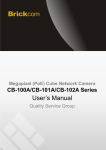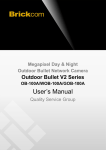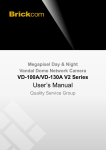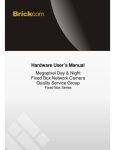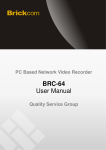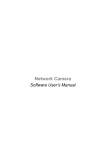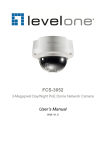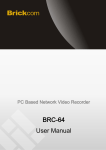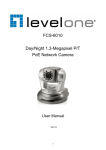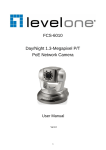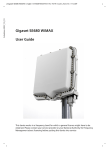Download PZ-040-PAL User Manual - 123SecurityProducts.com
Transcript
12x PTZ Network Camera PZ-040 12x Series User’s Manual Product name: Network Camera ( PZ-040 12x series ) Release Date: 2011/01 Manual Revision: V1.0 Web site: www.brickcom.com Email: [email protected] [email protected] © 2010 Brickcom Corporation. All Rights Reserved Table of Contents Before You Use This Product ....................................................................................... 1 Regulatory Information ................................................................................................. 2 Chapter 1 - Package Contents ...................................................................................... 3 Chapter 2 - 36x Outdoor Speed Dome Network Camera Overview ........................... 4 Chapter 3 - Device Appearance Description ............................................................... 5 Chapter 4 - LED Behavior ............................................................................................. 6 Chapter 5 - Installation .................................................................................................. 7 5.1 Hardware Installation ...................................................................................... 7 5.2 Camera Connection ....................................................................................... 10 5.3 System Requirements ................................................................................... 12 5.4 Software Installation ...................................................................................... 13 5.4.1 EasyConfig ............................................................................................ 21 Chapter 6 - Accessing the Network Camera.............................................................. 29 6.1 Check Network Settings ................................................................................ 29 6.2 Add Password to Prevent Unauthorized Access ........................................ 29 6.3 Authentication................................................................................................ 30 6.4 Installing the Plug-In ..................................................................................... 31 Chapter 7 - Live View................................................................................................... 32 Chapter 8 - Configuration ........................................................................................... 35 8.1 Camera/Video/Audio ...................................................................................... 35 8.1.1 Camera .................................................................................................. 35 8.1.2 Video...................................................................................................... 37 8.1.3 Audio...................................................................................................... 40 8.1.4 Multicast................................................................................................. 41 8.2 Camera Control .............................................................................................. 42 8.2.1 Preset Point ........................................................................................... 42 8.2.2 Privacy Mask Control ............................................................................. 43 8.2.3 Patrol Setting ......................................................................................... 44 8.3 Network .......................................................................................................... 45 8.3.1 IP Settings ............................................................................................. 45 8.3.2 UPnP ..................................................................................................... 46 8.3.3 DDNS (dynamic domain name service) ................................................. 47 8.3.4 EasyLinkTM ............................................................................................. 48 8.3.5 HTTP/HTTPS......................................................................................... 49 8.4 Event ............................................................................................................... 51 8.4.1 Event Settings ........................................................................................ 51 8.4.2 Motion Detection .................................................................................... 55 8.4.3 Digital Input (DI) ..................................................................................... 56 8.5 Notifications ................................................................................................... 57 8.5.1 FTP Settings .......................................................................................... 57 8.5.2 E-mail Settings ....................................................................................... 58 8.5.3 Samba Settings ..................................................................................... 59 8.5.4 HTTP Settings........................................................................................ 60 8.5.5 Digital Output (DO) ................................................................................ 61 8.5.6 Video Clip .............................................................................................. 61 8.6 System ............................................................................................................ 62 8.6.1 System Log ............................................................................................ 62 8.6.2 Date and Time ....................................................................................... 64 8.6.3 Device Information ................................................................................. 65 8.7 Maintenance ................................................................................................... 66 8.7.1 User Management ................................................................................. 66 8.7.2 Language ............................................................................................... 67 8.7.3 IP Filter .................................................................................................. 67 8.7.4 Firmware Upgrade ................................................................................. 68 8.7.5 Configuration ......................................................................................... 68 8.7.6 Reset to Default ..................................................................................... 69 8.7.7 Reboot ................................................................................................... 69 Before You Use This Product In many countries, there are laws prohibiting or restricting the use of surveillance devices. This Network Camera is a high-performance, web-ready camera which can be part of a flexible surveillance system. It is the user’s responsibility to ensure that the operation of this camera is legal before installing this unit for its intended use. Upon opening the product’s package, verify that all the accessories listed on the “Package Contents” are included. Before installing the Network Camera, read the warnings in the “Quick Installation Guide” to avoid misuse. When installing the Network Camera, carefully read and follow the instructions in the “Installation” chapters to avoid damages due to faulty assembly or installation. 1 Regulatory Information Federal Communication Commission Interference Statement This equipment has been tested and found to comply with the limits for a Class B digital device, pursuant to Part 15 of the FCC Rules. These limits are designed to provide reasonable protection against harmful interference in a residential installation. This equipment generates uses and can radiate radio frequency energy and, if not installed and used in accordance with the instructions, may cause harmful interference to radio communications. However, there is no guarantee that interference will not occur in a particular installation. If this equipment does cause harmful interference to radio or television reception, which can be determined by turning the equipment off and on, the user is encouraged to try to correct the interference by one of the following measures: - Reorient or relocate the receiving antenna. - Increase the separation between the equipment and receiver. - Connect the equipment into an outlet on a circuit different from that to which the receiver is connected. - Consult the dealer or an experienced radio/TV technician for help. FCC Caution: Any changes or modifications not expressly approved by the party responsible for compliance could void the user's authority to operate this equipment. This device complies with Part 15 of the FCC Rules. Operation is subject to the following two conditions: (1) This device may not cause harmful interference, and (2) this device must accept any interference received, including interference that may cause undesired operation. IMPORTANT NOTE: FCC Radiation Exposure Statement: This equipment complies with FCC radiation exposure limits set forth for an uncontrolled environment. This equipment should be installed and operated with minimum distance 20cm between the radiator & your body. This transmitter must not be co-located or operating in conjunction with any other antenna or transmitter. The availability of some specific channels and/or operational frequency bands are country dependent and are firmware programmed at the factory to match the intended destination. The firmware setting is not accessible by the end user. 2 Chapter 1 - Package Contents a. Network Camera (PZ-040 12x) b. Product CD c. Mounting Kit d. I/O Cable e. Easy Installation Guide f. Alignment Sticker g. Screw Bag h. Warranty Card 3 Chapter 2 - 12x Outdoor Speed Dome Network Camera Overview The Brickcom PZ-040 12x series is a high-end PTZ network camera which offers 360-degree indoor protection. The 12x optical/digital zoom and pan/tilt design enable the PZ-040 12x series to provide the ultimate solution for lobby, office, and bank surveillance. The PZ-040 12x series is unmatched in its ability to provide end users with superb video surveillance while allowing for easy installation and use. Support for Power over Ethernet (PoE) simplifies the installation process by allowing the camera to receive power and transmit data through the same cable. The EasyConfig. software allows for easy management of the PZ-040 12x series’ many features. H.264, M-JPEG, and MPEG-4 triple codec compression offer end users a flexible system which does not require high bandwidth and storage capabilities. There are many features of the PZ-040 12x series which enable it to provide 360-degree, 24-hour video surveillance. The PZ-040 12x series has a precise pan/tilt mechanical design which allows the camera to capture a panoramic view with 360-degree continuous pan and 90-degree tilt. The 12x motorized zoom lens with auto focus enables end users to capture a clear, detailed shot of objects. Other specific features of the PZ-040 12x series include the Sony Super HAD CCD sensor, built-in IR-cut filter, IR illuminator LEDs, and Auto Light sensor. 4 Chapter 3 - Device Appearance Description < Bottom View > 12 IR LEDs Light Sensor < I/O Connectors > Ethernet RJ45 10/100 Socket DC Power Connector General I/O Terminal Block Audio Out (Red) Microphone/Line In (Green) Video Out I/O Cable 5 Chapter 4 - LED Behavior Function LED Behavior Description Power LED Continuous illumination Power on Power LED Unit Power off ACT/Link LED Continuous illumination Link ACT/Link LED Blinking Connecting 6 Chapter 5 - Installation 5.1 Hardware Installation A. Connect the supplied I/O cable to the camera. B. Install the Mounting Kit Hard Ceiling Mount Soft Ceiling Mount 1) Choose a location on the wall or ceiling to place the camera. Attach the location sticker to the desired spot. Drill holes through the three location holes and cable hole on the sticker. 2) For Hard Ceiling Mount, hammer the three plastic anchors that are provided into the three location holes. For Soft Ceiling Mount, place the hollow plate on the back side of the ceiling and align the three holes on the plate with the screw location holes. 7 3) Mount the metal plate on the ceiling and position the three screw slots over the plastic anchors. Insert the three screws provided in the product package into the holes and use a screwdriver to tighten the screws clockwise until they are secure. C. Loosen the screw on the rim of the metal plate but do not remove the screw completely. D. Push all cables and connectors through the cable hole into the ceiling, and attach the PTZ camera to the metal plate. E. Turn the PTZ camera counter clockwise until it is in a locked position. 8 F. Tighten the screws on the metal plate. 9 5.2 Camera Connection A. Basic Connection (Without PoE) 1) Connect supplied I/O cable to the camera. 2) Connect the power adapter from the camera to a power outlet. Note: A DC12V 2A power adapter is required. B. Power over Ethernet(PoE) Connection The PZ-040D/E is High Power PoE compliant, so there are two options for connecting the camera to a power and Ethernet source. The camera can either be connected to a High PoE-enabled switch or a non-PoE switch 1) If using a High Power PoE-enabled switch Use a single Ethernet cable to connect the camera to the High Power PoE-enabled switch. 10 Note: The PoE switch must be able to provide IEEE802.3at High Power PoE. It is recommended that a Brickcom PS-7242-AT 24 port high power PoE switch be used. 2) If using a High Power PoE-enabled switch i. Use a standard Ethernet cable to connect the camera to a High Power PoE Injector. ii. Use a standard Ethernet cable to connect the High Power PoE Injector to the non-PoE switch. iii. Use a standard power cable to connect the High Power PoE Injector to a power outlet. Note: The PoE injector must be able to provide IEEE802.3at High Power PoE. It is recommended that a Brickcom POE30U high power PoE injector be used. 11 5.3 System Requirements Operating System: Microsoft Windows XP Home Edition SP2 Microsoft Windows XP Professional SP2 Computer: IBM PC/AT Compatible CPU: Pentium 3GHz or faster Memory: 1024 MB or more Monitor: 1024 x 768 pixels or more, 24-bit True color or better Network Interface: 10/100Mbps Network interface card must be installed Web Browser: Microsoft Internet Explorer 6.0 SP2 or higher Adobe Reader: Adobe Reader 8.0 or higher Audio: The audio function will not work if a sound card is not installed in the PC. Audio may be interrupted depending on network traffic. 12 5.4 Software Installation In this manual, "User" refers to whoever has access to the Network Camera, and "Administrator" refers to the person who can configure the camera and grant user access to the camera. After checking the hardware connection, run the Installation Wizard program included on the product’s CDROM to automatically search the intranet for the camera. There may be many cameras on the local network. Differentiate the cameras using the serial number which is printed on the labels on the carton and the bottom of the camera. A. Insert the Installation CD into the CD-ROM driver. Run Auto-Run Tool directly from the CD-ROM to start the installation. When installing the Brickcom software kit for the first time, select a desired language for the interface. The available languages are listed in the scroll box. Click <Install> and follow the steps to install the EasyConfig wizard on the desired computer. 13 B. In the Install Shield Wizard dialog box, click <Next> to continue. C. Read the End-User License Agreement and check the option “I accept the terms of the license agreement”. Click <Next> to continue. 14 D. Select either “Complete” setup or “Custom” setup to install the system. a. If COMPLETE SETUP is selected: i. All program features will be installed into the default directory. Check the option “Complete” and then click <Next>. ii. Click <Change> to change the appointed folder where installation and program files will be stored. Click <Next> to continue. 15 iii. Select to create shortcuts. Click <Next> to continue. iv. The installation information will be displayed. Click <Next> to continue. 16 v. To launch EasyConfig or PC-NVR Standard, select the application and click <Finish>. When launching the PC-NVR program, please refer to the PC-NVR user manual. b. If CUSTOM SETUP is selected: i. This option is recommended for advanced users. It can be used to install the system to a preferred directory or to select specific program feature(s). ii. Check the option “Custom”, and then click <Next>. 17 iii. Select the features to install. Click <Next> to continue. iv. Click <Change> to change the appointed folder where installation and program files will be stored. Click <Next> to continue. 18 v. Select programs to create shortcuts. Click <Next> to continue. vi. The installation information will be displayed. Click <Next> to continue. 19 E. To launch EasyConfig or PC-NVR Standard, select the application and click <Finish>. When launching the PC-NVR program, please refer to the PC-NVR user manual. 20 5.4.1 EasyConfig To launch EasyConfig, select EasyConfig from the start menu. If Complete Setup type was used in the software installation, an EasyConfig icon was installed on the desktop. Double click to open the icon. If Custom Setup type was used in the software installation and an EasyConfig icon was not installed on the desktop, the program will be installed under C:\Program Files\Brickcom\EasyConfig unless the program was saved to a preferred directory. A. Click <Start> to continue. camera in the intranet. The program will automatically search for the NOTE - Check “Skip the hardware installation guide” to skip checking the hardware connection. To check the hardware installation settings, do not check the option box. 21 22 B. Select either “Simple Mode” or “Professional Mode” to obtain the camera’s IP settings. If “Simple Mode” is selected, EasyConfig will set up the connection automatically. If “Professional Mode” is selected, the user will need to configure the IP settings manually. 23 C. There may be many cameras in the local network. Differentiate the cameras using their UPnP name. Double click on the camera from the survey list to connect. D. For configuring the IP address settings, select either <Settings remain the same>, <Automatically obtain an IP Address (DHCP)> or <Set IP Address configuration manually>. The DHCP setting is recommended. 24 If <Set IP Address configuration manually> is selected, the following pages will be displayed. 25 E. If the camera supports the EasyLinkTM function, the following page will be displayed. Otherwise, this page will not be shown. *If desired, click <Skip> to skip this setting. EasyLinkTM is a unique Brickcom function which allows users to assign a unique EasyLink name to their network camera’s IP address. There is no need to configure the router to open up ports or remember hard-to-memorize IP addresses. Users can log onto [uniqueEasyLinkname].mybrickcom.com to view the camera’s web GUI and live view. a. Enter a unique EasyLink name whose length must be between 5-32 characters. b. When finished, click the arrow button to continue. 26 F. When the IP address settings have been configured, the screen will either display a successful or failed connection message. If the connection failed, either try again or quit the installation. a. If “DHCP IP address settings” was selected, the failure page will be displayed as below: b. If “Static IP address settings” was selected, the failure page will be displayed as below: 27 c. If the connection was successful, the user will see the message: “Congratulations. The installation of the camera is complete.” When this window is displayed, click <PC-NVR> to start the PC-NVR program, <Live View> to view the live video from the connected IP camera, or <X> in the top right corner of the screen to close the installation window. If the user starts the PC-NVR program, please refer to the PC-NVR user manual. Once installation is complete, the Administrator should proceed to the next section "Accessing the Network Camera" for necessary changes and configurations. 28 Chapter 6 - Accessing the Network Camera 6.1 Check Network Settings The camera can be connected either before or immediately after the software installation. The Administrator should complete the network settings on the configuration page, including entering the correct subnet mask and IP address of gateway and DNS. Ask the network administrator or Internet service provider for the detail information. 6.2 Add Password to Prevent Unauthorized Access The Administrator should immediately implement a new password as a matter of prudent security practice. For first time use, the user name and password for the Administrator are assigned as “admin/admin”. After the Administrator changes the Administrator password, the web browser will display an authentication window to confirm the new password. Once the password is set, there is no provision to recover the Administrator’s password. If the Administrator’s password is lost, the only option is to restore the original factory default settings. The Administrator can set up a maximum of ten (10) user accounts. Users will be able to access the Network Camera, but will not be allowed to access system configurations. 29 6.3 Authentication To access the camera’s live view, open a web browser and enter the IP address of the camera. A dialog window will pop requesting a username and password. As stated on the previous page, for the default username and password for the Administrator are assigned as “admin/admin”. For accounts other than the administrator’s account, the user can choose to remember the password for future convenience. It is not recommended to check this box when viewing the camera feed from a public computer. 30 6.4 Installing the Plug-In For the initial access to the camera in Windows, the web browser may prompt the administrator for permission to install a new plug-in for on Internet Explorer. Permission request depends on the Internet security settings of the user’s PC or notebook. If the highest security level is set, the computer may prohibit any installation and execution attempt. This plug-in has been registered for certificate and is used to display the video in the browser. Click “Install” to proceed. If the web browser does not allow the administrator to continue the installation, check the Internet security option and lower the security levels or contact the networking supervisor or IT for help. NOTE – If an error occurred or the plug-in fails to install, it is because the version of the Electronic Signature is newly released and the VeriSign has not been submitted to Microsoft Windows update for validation. Therefore, plug-in will not have its root certificate. If IE discovers that there is no root certificate after the user’s PC connects to the camera, it will automatically redirect to VeriSign Web site to download and install the latest root certificate to make the installation successfully. If the user’s computer is able to connect to camera but unable to access the internet, then the installation will fail because the computer will not be able to download the latest root certificate. This problem can be resolved if computer can be connect to the internet and the camera at the same time and will not recur when Windows update patches become available. 31 Chapter 7 - Live View Live View is the default page that opens when accessing the camera. Live video is displayed directly in the browser window. A. Stream1/Stream2 Channels The network camera offers simultaneous dual stream for optimized quality and bandwidth. Go to Configuration → Camera/Video/Audio → Video to configure the codec compression and video resolution or refer to the Video configuration page. B. HTTP/TCP/UDP protocol a. HTTP – This unicast method can be used to traverse firewalls. Firewalls are commonly configured to allow the HTTP protocol, thus allowing RTP to be tunneled. b. TCP - This protocol guarantees the complete delivery of streaming data and provides better video quality. The downside of using this protocol is that the quality of its real-time effect is less than that of the UDP protocol. c. UDP - This protocol allows for more real-time audio and video streams. However, network packets may be lost due to network burst traffic and images may be broken. Activate UDP connection time-sensitive responses are more important than video quality. 32 C. Go to Preset Position To view a preset position at any time, select the position from the Preset Positions drop-down menu and press <Go to>. NOTE - The Preset Position drop-down menu will appear after the user has set at least one preset position for the camera. D. Camera Control Panel a. Brightness - Drag the slider bar to adjust the image brightness level. b. Mic volume - Drag the slider bar to adjust the microphone volume. c. Speaker volume - The built-in speaker will play sound from an audio clip from the computer microphone when it is enabled. d. Optical Zoom - Drag the slider bar to adjust the optical zoom. The camera will automatically focus. e. Focus - Click on AF and MF to switch between Auto Focus and Manual Focus mode. Click on “+ (Near)” and “- (Far)” to manually adjust the focus range. For more Audio settings, please refer to the Audio configuration page. Play or Stop - Play or stop the video. Recording - Record video to a computer. Snapshot - Capture and save still images. Digital Zoom - Enable the digital zoom operation Mirror - Horizontally reflect the display of the live video. Flip - Vertically reflect the display of the live video. Real Size - View the object in real size. Press it again to switch back to normal mode. 33 Full Screen - Switch to full screen mode. Press the “Esc” key to return to normal mode. Motion Detection Alert - Enable the motion detection alert function. Mute – Turn off the sound. Talk – Communicate through the camera using the computer MIC. Set Default – Reset to default settings. Patrol - Enable the patrol function. If a designated patrol has not been set for that time period, the first patrol group on the patrol list will be enabled. Pan/Tilt Control - Click on the arrows to pan and tilt the camera. Click the center of icon to return to the home position. Joystick Mode – Scroll over the live view window to move the camera view in the direction of the mouse pointer. Center Mode - Click on a point in the live view window to center the camera view on that point. / Recording on/off - Displays the status of recording video / MIC on /off - Displays the status of the MIC volume / / Speaker on/off - Displays the status of the Speaker MD on/off - Displays the status of Motion Detection NOTE 1. Click on or to switch Joystick Mode and Center Mode. 2. The <Camera Control Panel> functions have no effect on the recorded video. Whatever changes are made to the <Camera Control Panel> will not be applied to the recorded video. 34 Chapter 8 - Configuration Click <Configuration> on the main page to change the camera settings pages. NOTE - Only Administrators can access the Configuration page. 8.1 Camera/Video/Audio 8.1.1 Camera a. Brightness - Drag the slider bar to adjust the image brightness level from -5 to +5. b. Contrast - Drag the slider bar to adjust the image contrast level from -5 to +5. c. Sharpness - Drag the slider bar to adjust the image sharpness level from -5 to +5. d. Saturation - Drag the slider bar to adjust the image saturation level from -5 to +5. 35 A. Auto Iris Enable to adjust iris automatically. B. True Day & Night a. Auto - The Network Camera automatically removes the filter by judging the level of ambient light. b. Manual - In day mode, enable the IR CUT to keep the IR cut filter active at all times so the infrared light does not reach the sensor and distort the color. In night mode. C. White Balance a. Disable - Disable the Auto White Balance function. b. AWB - Enable to adjust the White Balance automatically. White Balance is a feature used to compensate for different colors of light being emitted by different light sources. It allows the camera to calibrate the device to correctly display the colors. D. Auto Focus When this feature is enabled, the camera will focus automatically. Click Apply to apply settings or Cancel to cancel changes. 36 8.1.2 Video The Network Camera offers two separate streams for different viewing options. A. Stream 1 & Stream 2 a. Video Codec - The Network Camera offers three choices of video codec standards for real-time viewing: H.264, MPEG-4 and MJPEG. b. Video Resolution - Select from the drop-down menu to choose the best resolution recording settings. c. Frame Rate - Select the frame rate from drop-down menu. When H.264 or MJPEG is selected, the frame rate ranges from 1 to 30 fps. When MPEG-4 is selected, the frame rate ranges from 1 to 15 fps. Set a higher frame rate for smoother video quality. d. Video quality and bit rate - Choose either “quality” or “bitrate” to control the video quality with video codec at H.264 or MPEG4. Only “quality” can be chosen when video codec at MJPEG is selected. Set the bitrate higher for a better video quality. NOTE - a higher bitrate will use higher network bandwidth. The video quality can be set between Level 1 to Level 6, with Level 6 producing the best image quality. 37 e. HTTP Transport – If MJPEG is used for Video Codec, users can enable HTTP Transport protocol for video communication. NOTE – HTTP Transport is for non-IE browser used only. Click Apply to apply settings or Cancel to cancel changes. NOTE – For best recording experience, configure the Network Camera to one of the following frame rates based on the Flicker-Free setting: Flicker-Free Frame Rate Outdoor Indoor (50/60 Hz) 25, 10, 7, 5, 3, 2 25, 20, 10, 7, 5, 3, 2 B. Video Overlay a. Timestamp - To display the date and time on the screen during live view, check “Enable” to enable the timestamp function and select the display position from the drop-down menu. b. Text - To make a note about the camera, check “Enable” and select the display position from the drop-down menu. Enter a video description in the text box. Click Apply to apply settings or Cancel to cancel changes. NOTE - The video overlay will only takes effect in stream 1. 38 C. RTSP Server To utilize RTSP authentication, the user must first set a password for the camera. RTSP (Real-Time Streaming Protocol) controls the delivery of streaming media. By default the port number is set to 554. a. Authentication - Depending on the network security requirements, the camera provides two types of security settings for streaming via RTSP protocol: NONE and DIGEST. If DIGEST authentication is selected, user credentials are encrypted using MD5 algorithm, thus providing better protection against unauthorized access. Click Apply to apply settings or Cancel to cancel changes. D. Save File Folder a. Recording folder path - The destination for saving the recording video files. Click Browse to specify the saving path. b. Snapshot folder path - The destination for saving the snapshot files. Click Browse to specify the saving path and select the format from the drop-down menu. Click Apply to apply settings or Cancel to cancel changes. 39 8.1.3 Audio A. Stream The administrator can set up two separate streams for the camera for different viewing devices. The administrator can enable or disable the audio function on either stream. If audio enable is selected, select the Audio codec from the drop-down menu. B. Advanced Settings a. Camera Speaker – If the speaker is enabled, select the volume from the drop-down menu. b. Echo Cancellation Enabled - Enable to avoid an echo. Click Apply to apply settings or Cancel to cancel changes. 40 8.1.4 Multicast Multicast sends a video stream to the multicast group address and allows multiple clients to acquire the stream at the same time by requesting a copy from the multicast group address. Therefore, multicast can effectively save Internet bandwidth. The RTSP (Real-Time Streaming Protocol) controls the delivery of streaming media. Click “Enable” to enable Multicast stream 1 or Multicast stream 2. The default value for multicast address and port are 234.1.2.3 and 10000. Use different port number for different streams. It is recommended to use the default values. NOTE - Using the IP address of the Network Camera enables access to the video. Example: rtsp://192.168.1.1/channel1 Click Apply to apply settings or Cancel to cancel changes. 41 8.2 Camera Control 8.2.1 Preset Point A preset position is a pre-defined camera view that can be used to quickly move the camera view to a specific location. To create a preset position: a. Use the Pan, Tilt and Zoom (PTZ) controls to steer the camera view to the required position. b. Enter a descriptive name under Current Position and click Add. c. The camera position and focus settings will be saved as a preset position. NOTE – A total of sixteen preset points can be set. a. Preset Positions can be assumed at any time by selecting the preset position's name from the available positions drop-down list. One position can be set as the Home position, which is readily accessible by clicking the Home button in the PTZ panel. NOTE - The name of the preset point set as Home will have (H) added; for example, Gate (H). b. The camera can be configured to return to the Home position when the camera has been inactive for a specified length of time. Select the desired length of time from the drop-down menu and click Apply. Setting the time to zero prevents the camera from automatically returning to the Home position. 42 8.2.2 Privacy Mask Add / Edit Privacy mask A privacy mask can be created to conceal areas within the camera’s view. The Privacy Mask List displays all the masks that are currently configured for the network camera and if they are enabled. NOTE – A total of sixteen privacy masks can be created. To create a new privacy mask: a. Use the Pan, Tilt and Zoom (PTZ) controls or select Preset Point from the drop-down menu to steer the camera view to the required position. b. Click on Add. A rectangle will appear on the center of the viewing window. c. Use the mouse to resize the privacy mask window. d. Enter a descriptive name in Mask name, choose a color from the Privacy mask color drop-down menu and click Apply. To edit a privacy mask, select the mask and reshape, move or change the color as needed. 43 8.2.3 Patrol Settings The camera can be set to patrol a group of preset points. For each patrol group, the user can configure the preset point order, movement speed, and viewing duration. To create a patrol group: a. Click on Add and enter a descriptive name in Description. b. Add preset points to the patrol group by clicking the preset point. next to the desired c. Use the arrow buttons to change the order of the preset positions by using the Adjust the sequence of positions, and enter Movement Speed and Viewing Duration for each preset point. d. Click on Apply to save the patrol group. e. Enable a patrol set by clicking on Start/Stop. NOTE 1. A total of sixteen preset points can be assigned to a patrol group. 2. A total of four patrol groups can be assigned to a network camera. 44 8.3 Network 8.3.1 IP Settings This section explains how to configure a wired network connection for the camera. There are several ways to setup the camera over the Internet: (1) obtain an available dynamic IP address assigned by a DHCP server, (2) use a static IP, or use PPPoE (Point-to-point over Ethernet). Select the desire setup mode from the IP settings drop-down menu. a. DHCP –If this option is selected, the camera will automatically obtain an available dynamic IP address from the DHCP server each time it connects to the LAN. b. Static IP - Select this option to manually assign a static IP address to the camera. Enter the static IP address, Subnet mask, Default Gateway, Primary and Secondary DNS provided by the ISP. 45 c. PPPoE (Point-to-point over Ethernet) - Use this mode if connecting to the Internet through a DSL Line. NOTE - To utilize this feature, it requires an account provided by an Internet Service Provider. Enter the user name and password provided by the ISP. Click Apply to apply settings or Cancel to cancel changes. 8.3.2 UPnP Universal Plug and Play (UPnP) simplifies the process of adding a camera to a local area network. Once connected to a LAN, the camera will automatically appear on the intranet. Click “Enable” to enable this function and enter an UPnP name which the camera will appear under on the intranet. Click Apply to apply settings or Cancel to cancel changes. 46 8.3.3 DDNS (dynamic domain name service) DDNS links a domain name to an IP address, allowing users to easily access their camera even with a changing IP address. Brickcom network cameras are compatible with two DDNS service providers (1) DynDNS, and (2) TZO. NOTE - Before utilizing this function; please apply for a dynamic domain account from a DDNS provider. a. DynDNS – Enable the DynDNS to allow the camera to have a fixed host and domain name. Refer to the DynDNS website (www.dyndns.com) to apply for a dynamic domain account. When an account has been created, enter the username, password and hostname. Click Apply to apply settings or Cancel to cancel changes. b. TZO - TZO is a DDNS provider which allows users to create a dynamic DNS. Refer to the TZO website (http://www.tzo.com/) to apply for a dynamic domain account. When an account has been created, enter the e-mail address, password and domain name. Click Apply to apply settings or Cancel to cancel changes. 47 8.3.4 EasyLinkTM EasyLinkTM is a unique Brickcom function which allows users to assign a unique domain name to their network camera’s IP address. There is no need to configure the router to open up ports or remember hard-to-memorize IP addresses. When this function is enabled, users can log onto [uniquedomainname].mybrickcom.com to view the camera’s web GUI and live view. a. Check the box to enable EasyLinkTM. b. Enter a unique domain name whose length must be between 5-32 characters. Verify that the domain name is available. c. Select a desired amount of time from the Refresh Time drop-down menu to confirm the connection status. Click Apply to apply settings or Cancel to cancel changes. NOTE - The EasyLink function will not work if the following conditions occur: 1. The camera cannot be located behind a double NAT network. 2. The camera’s IP address cannot be assigned to specific port numbers using the router’s port forwarding. 3. EasyLink uses UPnP to exchange port information with the router. The camera must connect to the internet through a router which supports UPnP. 48 8.3.5 HTTP/HTTPS a. HTTP – (HyperText Transfer Protocol) - This protocol allows for TCP protocol quality without having to open specific ports for streaming. Users inside a firewall can utilize this protocol to allow streaming data through. b. HTTPS - (Hypertext Transfer Protocol over SSL) - This protocol allows authentication and encrypted communication over SSL (Secure Socket Layer). It helps protect streaming data transmission over the Internet on a higher security level than HTTP. Click “Enable” to enable and Apply to apply settings or Cancel to cancel changes. To enable HTTPS, users have to create and install a certificate. i. Click “Continue to this website” to install. 49 ii. Enter the User name and Password of the camera. iii. Click “Certificate Error” on the top right corner of the window to view the certificate. iv. Click “Install Certificate” and follow the steps to finish the installation. 50 8.4 Event 8.4.1 Event Settings When an event (such as unauthorized movement) occurs, the camera can be scheduled to perform certain actions. An Event Type is a set of parameters that defines these actions. This section describes how to configure the camera to perform certain actions when events occur. Click <Add Event> on the Event Settings page. The Event Setup page will appear. 51 How to Set Up an Event Schedule Event Schedule describes how and when the camera performs certain actions. a. Check “Enable” and enter a descriptive name for the event schedule. b. Set Event Schedule to define when the event is activated by selecting from Always (24 hours), Schedule or Recurrence pattern. i. If Schedule is selected from the Event Schedule, the following page will be displayed: A Scheduled Event can be programmed for certain times and day. Click individual boxes to schedule specific times for the camera to detect events. 52 ii. If Recurrence Pattern is selected, the following page will be displayed. An event schedule can be programmed to recur at different times according to the user’s needs. Select the days for the event schedule to occur. Select a start time and specify the duration. c. Define what will trigger an event to occur by selecting an option from the Event drop-down list. d. Select the Actions that will occur when the event is triggered. 53 i. When <Send to Email> is selected, the following page will be shown: 1) From - Enter the email address of the sender. 2) To - Enter the email address of the recipient. To enter multiple recipients, separate each using a comma. 3) My Name - Enter the sender’s name that will appear in the recipient’s inbox. 4) Subject - Enter the title of the email. e. When complete, click Apply to save new event or Cancel to delete the event. The new event will appear on the event list. f. To edit an event setting; select the event from the list. To remove an event setting from the list, select an event name from the list and then click <Delete Event>. Click <Add Event> to add more events. 54 8.4.2 Motion Detection Motion can be detected by measuring changes in the speed or vector of an object or objects in the monitored area. This section explains how to configure the Network Camera to enable motion detection. a. Detection Setting – Use this setting to enable and define the motion detection windows. The user can defined up to three areas on the live view window for motion detection. i. Select <Window1>, <Window2>, or <Window3> to adjust the motion detection window. ii. Check the box to enable the window. iii. Use the mouse to resize or move the motion detection window. iv. Adjust the “Sensitivity” level. Lower sensitivity levels will result in more activity needed to trigger an event. v. Adjust the “Threshold” to change the threshold level. The higher the threshold, the larger objects need to be to trigger an event. 55 vi. The chart below the Live View window indicates the activity level of the Motion Detection window. When motion is detected by the camera and exceeds the defined threshold, a red bar will appear. Users can use this feature as a trigger source to send photos or videos to a remote server via email or FTP. Click Apply to apply settings or Cancel to cancel changes. 8.4.3 Digital Input (DI) The DI socket allows the IP camera to receive input from an external device. The external device should have the ability to drive voltage on the connected DI wire to the triggering voltage level in order to notify the IP camera of any event of interest. The IP camera will then process the event notification according to the specific event rules. a. Triggering voltage Level: LOW or HIGH. Users should select the option according to the capability of their external device. NOTE – This function is only available for CB-101A and CB-102A models. 56 8.5 Notifications Use the tools in this section to specify what type of notification will be sent when an event occurs. The camera can send buffered images to an FTP server, Samba, Email, or HTTP. 8.5.1 FTP Settings File Transfer Protocol (FTP) is used as an application component to automatically transfer files for program internal functions. Select “Primary FTP Server” from the Server Selection drop down menu to send media files to a FTP server when an event is triggered. Enter the FTP IP address or hostname. By default, the FTP port server is set to 21. Enter the account name, password and FTP Path to configure the settings. Click Apply to apply settings or Cancel to cancel changes. 57 8.5.2 E-mail Settings Select “Primary Email Server” option from the Server Selection drop down menu to send media files to an email server when an event is triggered. a. SMTP Server - Enter the server host name of the email server. b. SMTP Port - Enter the port number of the email server; by default, the SMTP port is set to 25. c. Authentication - Select the authentication type from the drop-down menu. d. Email Account - Enter the user name of the email account if necessary. e. Email Password - Enter the password of the email account if necessary. Click Apply to apply settings or Cancel to cancel changes. 58 8.5.3 Samba Settings Select this option to send the media files via a network neighborhood when an event is triggered. a. Server Address - Enter the IP address of the Samba server. b. User Name - Enter the user name of the Samba server. c. Password - Enter the password of the Samba server. d. Workgroup - Enter the workgroup of the Samba server. e. Shared Folder - Enter the share folder of the Samba server. Click Apply to apply settings or Cancel to cancel changes. 59 8.5.4 HTTP Settings Select this option to send the media files via an HTTP notification when an event is triggered. a. URL – Specify the URL to send HTTP requests. The URL is normally written as: http://ip_address/notification.cgi?parameter ip_address – type the IP address or host name of the HTTP host. Parameter – type the notification parameter if necessary. Example URL - http://192.168.1.1/xxxx.cgi Message - name1=value1&name2=vlaue2 Result - http://192.168.1.1/xxxx.cgi? name1=value1&name2=vlaue2 (ex: https://192.168.1.1/notification.cgi?event=MD&camera=FB-100A) b. Message - Enter the message notification that will be sent when an event is triggered. c. Enter the user name and password if necessary. Click Apply to apply settings or Cancel to cancel changes. 60 8.5.5 Digital Output (DO) The DO socket allows the IP camera to send output to an external device. While executing the DO notification action, the IP camera drives voltage on the connected DO wire to the triggering voltage level for X number of seconds. The connected external device will then be triggered for X number of seconds. a. Triggered Voltage Level: OPEN or GROUND. Users should select the option according to the specification of their external device. NOTE – This function is only available for CB-101A and CB-102A models. 8.5.6 Video Clip This function is used to determine when video clips will be recorded and stored after an event is triggered. a. Pre-alarm buffer - Images can be stored internally on the server from the time immediately preceding the trigger. Enter the desired length of time. b. Post-alarm buffer - Images can be stored internally on the server from the time immediately following the trigger. Enter the desired length of time. c. Maximum buffer size – Specify the maximum file size allowed. Click Apply to apply settings or Cancel to cancel changes. 61 8.6 System 8.6.1 a. System Log System Log – Set up the camera to record a system log when an event is triggered. This page displays the system’s log in chronological order. The system log is stored in the camera’s buffer area and will be overwritten when the buffer area is full. Click Retrieve to retrieve the log or click Save to file to save the system log. 62 b. Remote Logging - The user can configure the camera to send the system log file to a remote server as a log backup. i. Click to enable remote log and enter the IP address of the remote server. ii. Enter the port number of the remote server. Click Apply to apply settings or Cancel to cancel changes. 63 8.6.2 Date and Time a. Manual – Manually enter the date and time. b. Clone from PC – The camera will sync with the time, date and time zone of the computer used to modify the camera settings. Check “Clone” to utilize this option. The read-only date and time of the PC will be displayed. c. NTP (Network Time Protocol) - NTP is a protocol for synchronizing the clocks of a computer system. Select to update the time with a NTP server on an hourly, daily, weekly, or monthly basis. i. Time Zone – Select the local time zone from drop-down menu. ii. NTP Server 1 and Server 2 - Enter the address of the NTP server iii. Daylight Saving - Enable this option to automatically update for Daylight Savings Time. Click Apply to apply settings or Cancel to cancel changes. 64 8.6.3 Device Information a. System Information – Displays the complete system information of the camera. b. Network Settings – Displays the complete network settings information of the camera. c. Video/Audio Settings – Displays the complete video/audio settings information of the camera. 65 8.7 Maintenance 8.7.1 User Management This section explains how to enable password protection and create multiple accounts. The administrator account name is “admin”, which is permanent and cannot be deleted. a. Click Add to create an account. b. Enter the new user’s name, password and confirm password. Administrators can add up to 10 user accounts. c. Select the privilege level for the new user account from the drop-down list. Privilege levels can be assigned as: 66 i. Administrator - user has access to view and change the Configuration page. Users with administrator privilege can change other user’s access rights and user accounts. Update to delete or modify a user’s account. Click Delete or ii. Viewer - user can only access the main page for live viewing. iii. Remote Viewer - user can only access the main page for live viewing using TCP protocol. Click Apply to apply settings or Cancel to cancel changes. 8.7.2 Language Select the desired language from the drop-down menu. Click Apply to apply settings or Cancel to cancel changes. 8.7.3 IP Filter The IP Filter is used to filter the IP addresses which are able to access the network camera. Enable the IP Filter and select to allow or deny a range of IP addresses access to the server. Click Add to list to add the IP range to the IP filter list. Click Apply to apply settings or Cancel to cancel changes. 67 8.7.4 Firmware Upgrade This feature allows the user to upgrade the camera firmware. It will take a few minutes to complete the process. NOTE - Do not power off the camera or camera during the upgrade. a. Upgrade - Click Browse… and specify the firmware file. Click Upgrade. The camera will begin upgrading and will reboot automatically when the upgrade is finished. 8.7.5 Configuration This feature allows the user to export/import the configuration files of the network camera. a. Import/Export - Click export to pop up a dialog to indicate the location and file to export. Click browse to indicate the location and file of the camera configuration and click import to import the configuration file back into the network camera. 68 8.7.6 Reset to Default Click Apply to restore the network camera to factory default setting. 8.7.7 Reboot This feature will reboot the camera. Click Apply to begin. A message will pop up asking “The device will reboot. Are you sure?” Click “OK” to continue. The camera will take about one minute to reboot. The following message will show during the rebooting process. When completed, the live video page will be displayed in the web browser. 69










































































